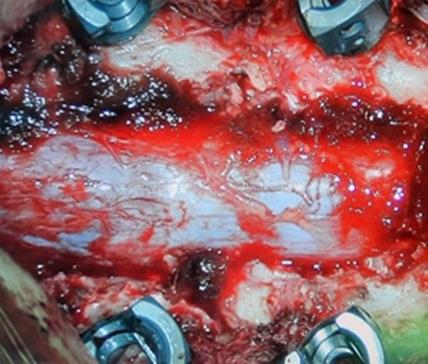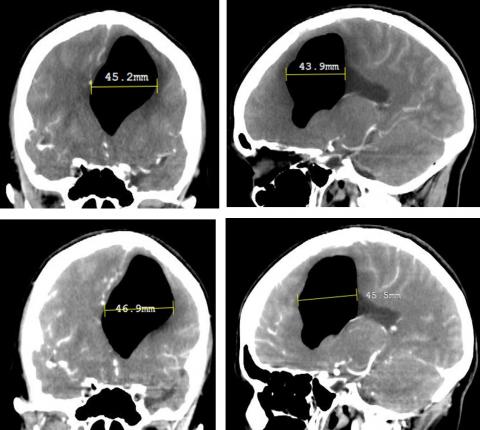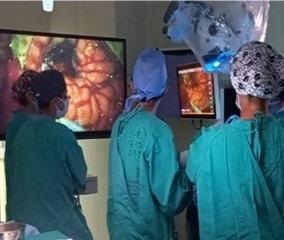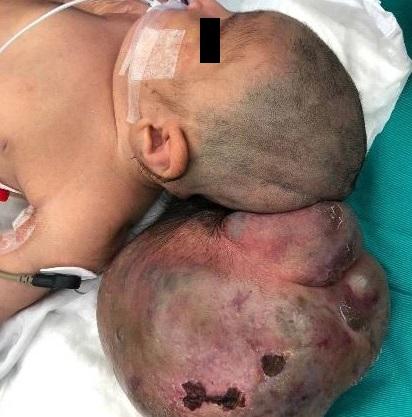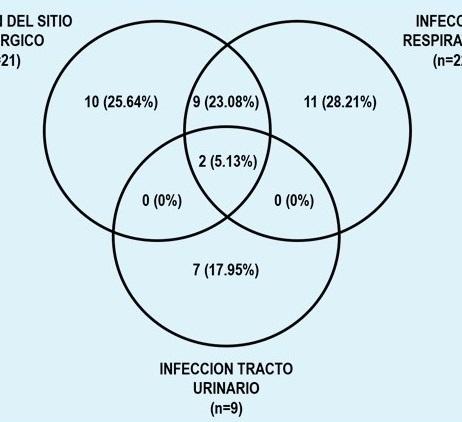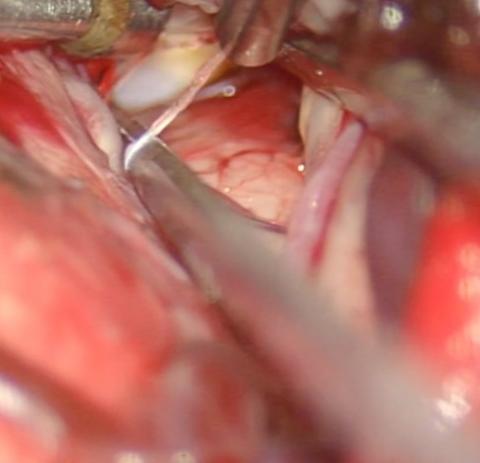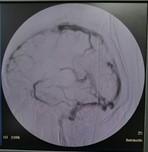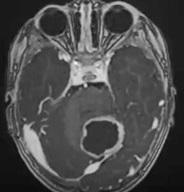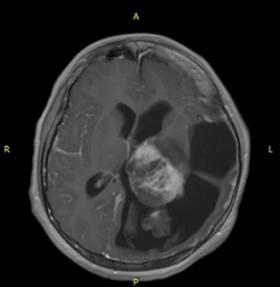Usted está aquí
Peruvian Journal of Neurosurgery
Ancient thoracic schwannoma: a rare etiology of spinal cord compression. case report
JOHN VARGAS U., JOSE LUIS URQUIZO R., ALFONSO BASURCO C.
Abstract (Spanish) ||
Full Text ||
PDF (Spanish)
ABSTRACT
Introduction: Ancient schwannoma is a rare subtype of spinal schwannomas. It is named for the degenerative changes that it can present. Contrast-enhanced magnetic resonance helps us diagnose, as it can show heterogeneous lesions that capture ring contrast. The treatment is surgical.
Clinical Case: A 67-year-old male patient is presented, with 2 years of the disease characterized by thoracic radicular pain and severe paraparesis in the last 6 months. Contrast-enhanced MRI showed a tumor with heterogeneous uptake, widening the right T2/T3 foramina with right anterior paravertebral extension and severe canal stenosis at the T2 level. A laminectomy plus total resection of the lesion was performed; the pathology study was reported as ancient schwannoma. The evolution was favorable with complete recovery of muscle strength in subsequent months.
Conclusion: Ancient schwannoma is a rare pathology that has peculiar imaging characteristics and whose treatment is surgical.
Keywords: Schwannoma, spinal neoplasms, paraparesis, laminectomy (Source: MeSH NLM)
Combined treatment “microsurgery-arthrodesis”: total resection of dorsal schwannoma plus dorsal arthrodesis
LIZERT AQUINO-FABIÁN
Abstract (Spanish) ||
Full Text ||
PDF (Spanish)
ABSTRACT
Introduction: Schwannomas are benign, unusual, and slow-growing tumors originating in Schwann cells, they constitute 30% of spinal tumors and are more common in women between the fifth and sixth decade. The symptoms depend on the location, degree of spinal cord compression, vertebral erosion, and tumor size. The diagnosis is clinical and imaging. The gold standard of treatment is total excision, to avoid recurrence. Surgical planning must be holistic, and the surgical field must be wide to allow complete excision.
Clinical case: A 65-year-old woman with symptoms of axial pain, with an imaging diagnosis of a spinal tumor, is presented. Total resection of the tumor was performed by means of a hemilaminectomy plus dorsal arthrodesis. The pathology result was spinal schwannoma. The patient evolved favorably without presenting a neurological deficit.
Conclusion: Hemilaminectomy plus posterior arthrodesis with facetectomy constitutes an effective way for total resection of extramedullary intradural tumors at the dorsal level, as was the case we performed in our patient. This allows for a larger operating field and optimizes the surgical approach.
Keywords: Spinal Cord Neoplasms, Neurilemmoma, Laminectomy, Arthrodesis. (Source: MeSH NLM)
Prognostic factors in the survival of patients operated of astrocytoma grade III at the Guillermo Almenara Hospital Lima- Peru. 2003-2009
JERSON FLORES C., ALEJANDRO ROSELL O.
Abstract (Spanish) ||
Full Text ||
PDF (Spanish)
ABSTRACT
Introduction: Anaplastic astrocytoma (AA) or grade III is a primary brain tumor, astrocytic, malignant, and diffusely infiltrating. The survival of patients depends on several clinical and treatment factors, being this unknown in our environment. The objective of this study was to determine the survival of patients operated on for grade III astrocytoma and the impact of preoperative and postoperative prognostic factors.
Methods: A retrospective, observational and longitudinal study of 35 patients operated on for astrocytoma grade III at Hospital Guillermo Almenara between 2003 and 2009 was carried out. Data were collected from medical records, operative reports, and telephone interviews. Patients with anaplastic astrocytomas were classified according to prognostic risk group, treatment type, and surgery extent. SPSS 25.0 was used for the analysis.
Results: Of a total of 124 patients with astrocytoma, 28.2% (35/124) had a grade III astrocytoma, with an average survival of 34.8 months. According to the clinical prognosis group, the survival of the low, medium, and high-risk groups was 46.7, 28.1, and 8.5 months, respectively. Regarding the type of treatment, the group with the longest survival was surgery + radiotherapy (39.5 months), followed by surgery + radiotherapy + chemotherapy (29.3 months), and the one with the lowest survival was surgery alone (6.5 months). According to the extension of the surgery, the highest survival was obtained by the total resection group (46.2 months), while the lowest survival was for the partial resection group (13.9 months).
Conclusions: The average survival of patients operated on for grade III astrocytomas in our hospital was 34.8 months, with the best prognostic factors being the "low risk" clinical group, the combined treatment of surgery + radiotherapy, and total resection. Its classification into prognostic risk groups based on pre-surgical clinical data helps us predict survival.
Keywords: Astrocytoma, Prognosis, Brain Neoplasms, Hospitals, Humans (source: MeSH NLM)
Glioma of the optic pathway and hypothalamus in a child: a case report
JOHN VARGAS U., MANUEL LAZÓN A., RAÚL MARTÍNEZ S., FERNANDO PALACIOS S.
Abstract (Spanish) ||
Full Text ||
PDF (Spanish)
ABSTRACT
Introduction: Gliomas of the optic nerve, visual pathway, and hypothalamus are treated as a single entity, being considered benign neoplasms in pediatric age, grade I according to the WHO. 25% of them are confined to the optic nerve, 40-75% involve the optic chiasm, and 33-60% are posterior lesions. Most do not present symptoms, but in the case of presenting, the most frequent is loss of vision. The gold standard for diagnosis is magnetic resonance imaging (MRI) with contrast. The first line of treatment is chemotherapy, with surgery used for nerve decompression, if necessary.
Clinical case: A 4-year-old woman with a 3-month illness characterized by headache, vomiting, and seizures. The MRI showed a heterogeneous, solid cystic tumor with a solid component that captures contrast. A craniotomy and partial tumor resection were performed, finding both nerves and the optic chiasm thickened. Pathology was reported as pilomyxoid astrocytoma. The patient presented a favorable evolution and was discharged on postoperative day 9.
Conclusion: Gliomas of the optic pathway and hypothalamus are tumors with a benign course in childhood, and their main form of treatment is chemotherapy. Surgery only plays an important role if decompression is required to preserve the patient's visual function.
Keywords: Astrocytoma, Optic Chiasm, Decompression, Craniotomy, Visual Pathways. (source: MeSH NLM)
Esthesioneuroblastoma with intracranial invasion, surgical management by double approach: craniotomy and craniofacial. case report
GIUSEPPE ROJAS P., MANUEL LAZÓN A.
Abstract (Spanish) ||
Full Text ||
PDF (Spanish)
ABSTRACT
Introduction: Esthesioneuroblastoma, or olfactory neuroblastoma, is a rare malignant neoplasm of the sinonasal tract that originates in the olfactory neuroepithelium with neuroblastic differentiation. It occurs most frequently in the upper nasal cavity. It is a locally aggressive neoplasm and metastasizes both hematogenously and lymphatic. A multimodal approach, which can combine surgery, chemotherapy, and radiotherapy, is essential for the management of these tumors.
Clinical Case: A 56-year-old female patient with an 18-month illness, characterized by loss of smell, shortness of breath, and frontal headache. Brain tomography showed an extensive tumor in the nasopharynx with intracranial involvement and destruction of the anterior skull base. She was diagnosed with Esthesioneuroblastoma by endonasal endoscopic biopsy. A combined approach was planned first by Neurosurgery, through a bifrontal craniotomy in which the resection of the intracranial portion and the reconstruction of the skull base were achieved. Then, Head and Neck Surgery perform the resection of the tumor in the nasal cavity through right lateral rhinotomy. The patient evolved favorably in the postoperative period without presenting neurological deficit, so she was discharged in the following days after the removal of the tracheostomy cannula. She subsequently received adjuvant chemotherapy and radiation therapy.
Conclusion: In an Esthesioneuroblastoma, obtaining an extensive resection, total, if possible, is a very important factor in the prognosis of a patient, so it is recommended to use the combination of several surgical techniques to achieve this goal.
Keywords: Esthesioneuroblastoma, Olfactory, Craniotomy, Nasal Cavity, Skull Base (source: MeSH NLM)
Post-surgical subarachnoid hemorrhage in endonasal endoscopic resection of pituitary macroadenoma without arachnoid opening
GIAN FRANCO REYES N, OLENKA SAPALLANAY O, JERSON FLORES C, FERNANDO PALACIOS S.
Abstract (Spanish) ||
Full Text ||
PDF (Spanish)
ABSTRACT
Introduction: Pituitary adenomas represent 90% of tumors in the sellar region. The surgery is performed by transsphenoidal resection (TSR) or transcranial resection (TCR); TSR can be by microscopy or endonasal endoscopy. Subarachnoid hemorrhage (SAH) associated with a pituitary tumor is rare and can be: Preoperative, due to pituitary apoplexy with rupture of the arachnoid into the basal cisterns, Intraoperative, due to vascular injury during surgery or rupture of an unidentified aneurysm; and Postoperative, due to residual tumor hemorrhage, or bleeding from small vessels adhered to the tumor capsule.1, 2
Clinical case: 46-year-old male patient with a clinical picture of bitemporal hemianopsia with left predominance. Magnetic resonance imaging and brain tomography showed a pituitary macroadenoma. Endoscopic endonasal resection of the tumor was performed without intraoperative opening of the arachnoid. On the 1st day, the evolution was favorable with improved visual fields, but on the 2nd day, the patient presented headache and increased visual deficit. Brain CT showed SAH in basal cisterns. Tomography angiography showed no vascular injury. The patient evolved favorably with the improvement of visual fields.
Conclusion: Subarachnoid hemorrhage associated with a pituitary adenoma has various causes that can be preoperative, intraoperative, and postoperative. The incidence of postoperative SAH as a complication of endonasal endoscopic resection is low, but it can affect the patient's prognosis. Excessive traction on the tumor capsule should be avoided.
Keywords: Subarachnoid Hemorrhage, Pituitary Neoplasms, Visual Fields, Arachnoid (source: MeSH NLM)
Spontaneous intraventricular pneumocephalus associated with transient aphasia: case report and review of the literature
ZINDYA BARRRIENTOS M., CAMILO CONTRERAS C.
Abstract (Spanish) ||
Full Text ||
PDF (Spanish)
ABSTRACT
Introduction: Pneumocephalus or the presence of air in the cranial cavity is common after a craniotomy and in patients with traumatic brain injury; however, its spontaneous appearance is extremely rare. So far, very few cases of spontaneous intraventricular pneumocephalus have been reported. We present the case of a patient who developed spontaneous intraventricular pneumocephalus, which required a craniotomy for surgical correction.
Clinical Case: A 59-year-old female patient with a history of left suboccipital craniotomy and resection of the left vestibular Schwannoma who after 2 years presented headache of 3 weeks duration and aphasia of expression. On examination: Mild expressive aphasia, surgical scar with no evidence of cerebrospinal fluid (CSF) leakage. Brain tomography (CT) showed pneumoventricle in the frontal and temporal horns of the left lateral ventricle and deviation from the midline; radionuclide cisternography was negative for CSF fistula and CSF analysis was normal. A left subtemporal craniotomy was performed, finding a bone defect in the petrous portion of the temporal bone above the internal auditory canal associated with a meningocele of the medial base of the skull, which was sealed with bone wax, fat, fascia lata, and biological glue.
Conclusion: The first case of spontaneous intraventricular pneumocephalus without identifiable CSF fistula is described, which made this case extremely rare. The treatment performed was a surgical correction of the meningocele through a subtemporal extradural approach, and the patient presented a favorable evolution with the improvement of the aphasia.
Keywords: Pneumocephalus, Aphasia, Meningocele, Craniotomy, Temporal Bone (source: MeSH NLM)
High-definition three-dimensional exoscopy-guided exeresis of a ruptured supratentorial cavernous angioma. Initial experience at the Dos de Mayo National Hospital.
JOSÉ LUIS ACHA S., LUIS CONTRERAS, MIGUEL AZURÍN, MANUEL CUEVA, ADRIANA BELLIDO; SHAMIR CONTRERAS
Abstract (Spanish) ||
Full Text ||
PDF (Spanish)
ABSTRACT
Introduction: We report the exeresis of a cerebral cavernoma, by using the extracorporeal telescope ("exoscope") operating system integrated into the Kinevo 900 microscope. The objective of this study was to evaluate the surgical potential of this novel high-speed 3D exoscope system. definition (4K-HD) for the removal of a brain cavernoma.
Clinical Case: A 47-year-old female patient was admitted to the emergency room for having presented intense headache with occipital predominance, the tomography showed a right occipital hematoma, the presence of a ruptured cerebral cavernoma was confirmed, so surgery was decided. The exoscope allowed good maneuverability of the instruments, without visual obstruction. The large 4K monitor made for an immersive surgical experience, giving multiple team members the same high-quality 3D view as the primary operator. It was also ergonomically favorable, allowing the surgeon to be in a neutral position regardless of the operative angle.
Conclusion: The novel system provided excellent visualization, ergonomics, and favorable maneuverability, the shared surgical vision of the exoscope with 3D lenses provided educational advantages for our residents. More cases are justified to validate this initial experience.
Keywords: Hemangioma, Cavernous, Central Nervous System, Telescopes, Ergonomics, Brain. (Source: MeSH NLM
Giant occipital encephalocele in a newborn; surgical treatment. Case report
GABRIELA ESPIN O., ALICIA TORRES M., JOSE RODOLFO BERNAL C., JESUS CASTRO V., ANDREA PAEZ C., BYRON SANUNGA V., CARLOS MORALES T., ENRIQUE CASTRO S.
Abstract (Spanish) ||
Full Text ||
PDF (Spanish)
ABSTRACT
Introduction: Neural tube defects (NTD) are congenital malformations that are caused by the lack of fusion of the neural tube during the embryonic period, exposing the nervous tissue to the outside. There are different types, and they can be cranial (anencephaly and encephalocele) and spinal (spina bifida). The encephalocele is a protrusion or herniation of the intracranial content, through the bony defect of the skull. In this article, we report the case of a patient diagnosed with occipital encephalocele, while reviewing the neurosurgical treatment performed in our hospital.
Clinical Case: We present the case of an 8-day-old male neonate, the son of a 36-year-old diabetic mother, with a prenatal ultrasound diagnosis of occipital encephalocele, evidenced at 16 weeks of gestational age. The patient underwent surgery, performing a plasty of the occipital encephalocele; he presented as a mediate complication infection of the surgical wound that was resolved with antibiotic treatment, later presenting a favorable evolution.
Conclusion: The extension and nature of the hernial content of the encephalocele determine its prognosis, as well as immediate treatment, which can reduce postoperative complications.
Keywords: Encephalocele, Neural Tube, Spinal Dysraphism, Nerve Tissue (Source: MeSH NLM)
Articulated robotic arm for assistance in interventional radiology
ROLANDO ORTEGA, IVAN ORTEGA, DEISY ACOSTA, JORGE POMA, LUZ CASTAÑEDA
Abstract (Spanish) ||
Full Text ||
PDF (Spanish)
ABSTRACT
|
Objectives: Robotic technology has helped medicine to reduce exposure time and offer greater efficiency and precision in surgical interventions. The goal of using an articulated robotic arm for X-ray (Rx) guided minimally invasive surgery and interventional assistance is to reduce direct and secondary radiation on physicians. The use of a collaborative robotic arm (COBOT) that replaces the operating arm of the surgeon-interventionist physician to avoid exposure to X-rays is described.
Methods: The COBOT has a remote-controlled electronic gripper and includes a special needle holder made using 3D printing technology; This holds the interventional instrument, needles, and other surgical elements. The instrument-loaded forceps are oriented and progressed toward intracorporeal therapeutic target points used in interventional radiology and radiation therapy procedures, the COBOT boasts operational precision.
Results: Its operation was verified by simulating the interventional action in models in animal tissue, and experimental surgery laboratory.
Conclusions: It is concluded that the robot arm can perform assistance functions in radiological and stereotaxic neuroradiological interventionism with a good level of precision, reducing the doctor's exposure to X-rays.
Keywords: Robotics, X-Rays, Radiology, Interventional, Robotic Surgical Procedures (Source: MeSH NLM)
|
Nosocomial infections in neurosurgery: a study of incidence, associated factors and etiology. Cayetano Heredia Hospital. April 2020 - March 2021
ELDER CASTRO C., ROMULO RODRIGUEZ C.
Abstract (Spanish) ||
Full Text ||
PDF (Spanish)
ABSTRACT
Objectives: To determine the incidence, associated factors, and etiology of nosocomial infections (NI) in patients hospitalized in a neurosurgery service.
Methods: Descriptive, retrospective, and cross-sectional study in patients 18 years of age and older, hospitalized in the Neurosurgery Service of Hospital Cayetano Heredia (HCH), between April 2020 and March 2021. Data were collected from medical records, registry care diary, and the HCH laboratory computer system.
Results: Of the total number of patients (n=116), the male sex (73.28%) and the age between 18 to 59 years (73.28%) predominated. 35.34% had at least one NI, being the most common pneumonia (18.97%) and surgical site infections (SSI) 18.10%. NI were associated with traumatic brain injury (TBI) (p=0.005), spinal cord trauma (SCI) (p=0.020), surgery (p=0.032), stay in Intensive Care Units (ICU) (p=0.000), hospital stay greater than seven days (p=0.000) and mortality (p=0.049). Pneumonia was associated with all the above factors, except trauma and surgery; while SSIs were associated with these factors except for SCI, the performance of surgery, and mortality. Gram-negative agents and enterobacteria were the most frequent in SSIs (72.73%) and pneumonia (94.74%).
Conclusions: NIs occurred in a third of the patients; increasing in those with traumatic pathology, undergoing surgery, admitted to the ICU, and prolonged hospital stay; thereby increasing mortality. It is unavoidable to consider the presence of Gram-negatives and enterobacteria when using antimicrobials in the treatment of NI in neurosurgical patients.
Keywords: Pneumonia, Surgical Wound Infection, Neurosurgery, Brain Injuries, Traumatic (Source: MeSH NLM)
Intracerebral hemorrhage of basal ganglia, surgical management through transinsular transylvian approach. case report
GIUSEPPE ROJAS P.1a, JESÚS FLORES Q.2b
Abstract (Spanish) ||
Full Text ||
PDF (Spanish)
ABSTRACT
Introduction: Acute spontaneous intracerebral hemorrhage is a life-threatening disease of global importance, with a poor prognosis and few effective treatments. For supratentorial intracerebral hemorrhage, early evacuation (<24 hours after hemorrhage onset) with standard craniotomy is considered lifesaving in deteriorating patients. In cases where the hemorrhage is less than 1 cm from the cortical surface, the clinical benefit is even greater.
Clinical case: We present the case of a 56-year-old obese male patient with a history of high blood pressure who was admitted with an extensive intracerebral hematoma in the basal ganglia of the right hemisphere. A right frontoparietotemporal craniotomy was performed, with the opening of the Sylvian fissure and approach through the insula, managing to evacuate the hematoma. The initial evolution was stationary, so it was necessary to remove the bone platelet, thereby achieving a favorable evolution, then performing the cranioplasty.
Conclusion: Surgical treatment of intracerebral hemorrhage of the basal ganglia through the transylvian transinsular approach has shown good results in several case series in terms of evacuation degree and functional outcome. In addition, this approach spares the frontal and temporal cortex, sometimes avoiding a decompressive craniectomy and its complications
Keywords: Cerebral Hemorrhage, Hematoma, Decompressive Craniectomy, Basal Ganglia (source: MeSH NLM)
Venous sinus thrombosis secondary to severe traumatic brain injury. case report
MARCOS VILCA A., MARCO MELGAREJO P., ERMITAÑO BAUTISTA C., CARLOS PALACIOS P., YURIKO VILLAREAL H.
Abstract (Spanish) ||
Full Text ||
PDF (Spanish)
ABSTRACT
Introduction: Cerebral venous thrombosis (CVT) is a rare type of cerebrovascular disease that can occur at any age and represents 0.5% to 1.5% of the total.1 Superior sagittal venous sinus thrombosis (SSVST) secondary to brain injury (BTI) is reported worldwide only as single cases or in small series.3,4 Headache is the most frequent symptom (90%). The most common focal signs are aphasia and hemiparesis. Papilledema occurs in 25% of cases and epilepsy in about 40%.1,4 Diagnosis is made by venous phase angiography, or by magnetic resonance imaging (MRI) with gadolinium or computed tomography (CT)1,2.
Clinical Case: 23-year-old woman who suffers a traffic accident as a passenger. He presented explosive vomiting, loss of consciousness and seizures, brain CT showed multiple bifrontal contusions, midline deviation> 5mm, cisternae of the base obstructed, Glasgow Coma Scale of 6. A decompressive craniectomy was performed and then he was transferred to ICU for management of intracranial hypertension. She presented with hydrocephalus, nervous system infection (ventriculitis) and superior sagittal venous sinus thrombosis.
Conclusion: SSVST post BTI is a rare cause of SSVST, but potentially dangerous if not diagnosed early. The magnitude of the trauma does not correlate with the appearance of VST. The most common symptom is headache, followed by seizures and signs of targeting, which correlate with lesions in the brain parenchyma.
Keywords: Sinus Thrombosis, Intracranial, Intracranial Hypertension, Brain Injuries (Source: MeSH NLM)
Intracerebral foreign body granuloma simulates a brain tumor. case report
JOHN VARGAS U., MANUEL LAZÓN A., MARCO MEJÍA T., JOHN MALCA B., FERNANDO PALACIOS S.
Abstract (Spanish) ||
Full Text ||
PDF (Spanish)
ABSTRACT
Introduction: An intracranial foreign body granuloma is a chronic inflammatory reaction, due to materials used in cranial surgery; this complication is rarely reported in neurosurgery. The definitive diagnosis is by pathological anatomy since the images are very similar to those of a brain tumor. Treatment is total resection of the lesion.
Clinical Case: A 2-year-old female patient, with a history of surgery for ventricular shunt and exeresis of a pilocytic astrocytoma, with contrast imaging study 6 months after surgery where a lesion suggestive of tumor recurrence was observed, for which she received chemotherapy with vincristine and carboplatin, without positive response. The patient presented to the examination, an extension of the base of support, Glasgow Coma Scale (GCS): 15 points. She underwent surgery, achieving total resection of the lesion. The final diagnosis was intracranial foreign body granuloma. The evolution was favorable, without neurological sequelae or residual tumor.
Conclusion: Intracranial foreign body reaction is a rare pathology but should be considered in the differential diagnosis of disease progression in neuro-oncology patients.
Keywords: Granuloma, Foreign-Body, Astrocytoma, Neoplasm, Residual, Brain Neoplasms, (source: MeSH NLM)
Fusocellular / pleomorphic sarcoma in a patient with Haberland syndrome
IVAN FLORES, JOHNNY MONTIEL, FAUSTO GUERRERO.
Abstract (Spanish) ||
Full Text ||
PDF (Spanish)
ABSTRACT
Introduction: The first case of pediatric spindle cell / pleomorphic sarcoma associated with Haberland syndrome or Encephalocraniocutaneous Lipomatosis, a rare ectomesodermal dysgenesis defined by the triad that includes ocular, skin, and central nervous system involvement, which is usually unilateral, is described. This disorder is attributed to a postzygotic mutation responsible for dysgenesis of the neural tube and crest.
Clinical Case: We present the case of a 10-year-old boy, who evolves with developmental delay, motor deficit, intellectual deficit, and epilepsy, associated with spindle cell / pleomorphic sarcoma. We describe his clinical evolution, electroencephalography, and neuroimaging of him.
Conclusion: The hypothesis that Haberland syndrome is associated with an increased risk of tumor development is intriguing, although the rarity of the disease currently prevents us from drawing definitive conclusions about this possible link between the two entities.
Keywords: Encephalocraniocutaneous lipomatosis, Sarcoma, Epilepsy, Central Nervous System. (Source: MeSH NLM)


